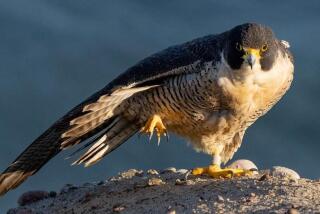Pan-American Forces Join to Save Condor
- Share via
BOGOTA, Colombia — The Andean condor, Earth’s largest flying bird, ruled the skies of Colombia and Venezuela at the beginning of this century. Often they could be seen from Bogota, drifting specks high above the green mountains overlooking the city.
But the Andean condor has suffered from some of the same pressures that have reduced the population of its smaller cousin, the California condor, to fewer than 30 birds, all in captivity.
The big birds no longer soar over the mountains near Bogota, and scientists fear that only a few dozen are left in this country. The condor already is extinct or nearly extinct in neighboring Venezuela.
In Colombia, a small but growing save-the-condor movement is looking for ways to guarantee the survival of the species in the face of obstacles that include a rapidly growing human population, pollution, deforestation, uncontrolled hunting and guerrilla warfare in the bird’s natural habitats.
Help For California Cousins
This month, scientists will begin releasing captive Andean condors in the Colombian wilderness. The Los Angeles and San Diego zoos are participating in the project, and scientists say the experience will be helpful in similar efforts to restore the California condor to the wild.
“It’s more information we can use with the California condor,” said Michael Wallace, curator of birds for the Los Angeles Zoo. “It will be real valuable.”
One of the condor’s handicaps is its slow rate of reproduction. The Andean condor, which weighs as much as 33 pounds and has a wingspan of up to 10 1/2 feet, will lay only one fertile egg every two years in ideal natural conditions.
But several American zoos have been tricking their captive condors into laying up to three eggs a year, simply by removing the eggs from their nests.
Some of the eggs have been shipped to the Los Angeles Zoo, which has been hatching them and preparing the young birds for release. Wallace was in Colombia recently to help plan the release project.
Tracking Birds in the Wild
Five male condors, now about a year old, will be brought to Colombia from the Los Angeles Zoo before the end of May. Small radio transmitters will be attached to them, and they will be put on a net-enclosed platform high in the Andes east of Bogota.
After about a month, the net will be taken away, and the condors will be induced to feed on meat left at increasing distances from the platform.
“We have to teach them to forage for carrion,” Wallace said.
The Andean condor, or Vultur gryphus , does not kill for food but feeds on dead animals, like other members of the vulture family. In fact, Wallace said, the released condors will pick up scavenging skills by imitating smaller vultures around them.
“They learn to associate food with other vultures,” he said.
Wallace, an ornithologist, conducted the first scientific release of Andean condors from 1980 to 1984, when he was working on a doctoral degree from the University of Wisconsin. In the Peruvian Andes, he released 11 condors that had been hatched in American zoos, then observed seven of the radio-tagged birds in the wild.
“They did quite well,” Wallace said. “They integrated very well with the wild population.”
Peru, he said, has more than 1,000 Andean condors.
Trial Runs in the North
Researchers also are releasing radio-tagged Andean condors--females only, to prevent reproduction--in California as a trial run for the later release of California condors.
In Colombia, the first condors released will be males. After they learn to survive on their own and as they approach mating age, females will be freed to join them.
The first releases will be in a national park 25 miles east of Bogota, where the condor disappeared years ago.
Meanwhile, scientists will study the little-known habits of a small group of condors farther south in the Andes, near the Cumbao volcano. The study will be useful for conditioning birds in release projects, Wallace said.
“If you don’t understand what the Andean condors are doing naturally, how can you get them to behave naturally?” he asked.
Guessing at Populations
Estimates of the total number of Andean condors in Colombia range from the 30s to the 70s, but no scientific census has been conducted. Jose Vicente Rodriguez, an ornithologist with the Colombian government’s environmental agency, said Colombia’s only major population of the birds is in the Sierra Nevada de Santa Marta, near the Caribbean coast.
“In the rest of the Colombian Andes, they have disappeared almost completely,” said Rodriguez, who is in charge of the scheduled release program. “We don’t worry about how many are left but about how many places where none are left.”
He said that if the release project is successful, the condor eventually will be reintroduced in many areas where it has disappeared.
“From the technical point of view,” Rodriguez said, “to raise them and release them is easy. The problem is whether they will survive in the natural environment.”
The park where the first birds are to be released is well stocked with rabbits, rodents and other small game. But larger animals that condors once fed on, such as Andean deer and Paramo tapirs, have become scarce or have disappeared.
Rodriguez said the condor project is part of a government campaign to preserve all threatened and endangered species in Colombia.
“We want to start strong with the condor, so that it will be a symbol,” he said.
Guerrilla War Geography
A private conservation group called Profauna is conducting an education campaign that includes the distribution of four different videotapes about the condor and its natural environment. Roberto Tovar, president of Profauna, said the group wants to establish an accurate count of Colombia’s condors and survey their natural areas but has been unable to do so because of guerrilla activity.
“These are zones of confrontation between leftist groups and the government,” Tovar said in an interview. “There is no security, which is the least that we must offer our biologist.”
The gunfire of guerrilla conflicts also scares away animals that condors feed on, and the guerrillas hunt the same animals for food, Tovar said. Conflicts in lower areas send displaced peasants fleeing into the condor’s habitat, he said.
“Besides that, we have the problem of narcotics traffic,” he said. “Extensive areas of forest are cut down to plant coca and marijuana.”
Farmers’ Unrealistic Fears
The condor nests high in the Andes, but with a flying radius of up to 75 miles a day it forages over large areas. As the natural environment has been degraded by spreading human population and agriculture, surviving condors have increasingly relied on the carcasses of cattle and sheep for food.
“It has helped them survive,” Tovar said. “But cattlemen and sheepherders have the false belief that condors steal calves and lambs. So they persecute the condor. They kill it.”
Others hunt the condor, he said, in the belief that eating its eyes strengthens visual powers, that its bones cure rheumatism and that its heart is an aphrodisiac.
A pamphlet prepared by Profauna lists more than a dozen Andean areas of Colombia where the condor is believed to have disappeared, including Cundinamarca, the mountainous state that surrounds Bogota. Cundinamarca means “heights where the condor flies.”
More to Read
Sign up for Essential California
The most important California stories and recommendations in your inbox every morning.
You may occasionally receive promotional content from the Los Angeles Times.










